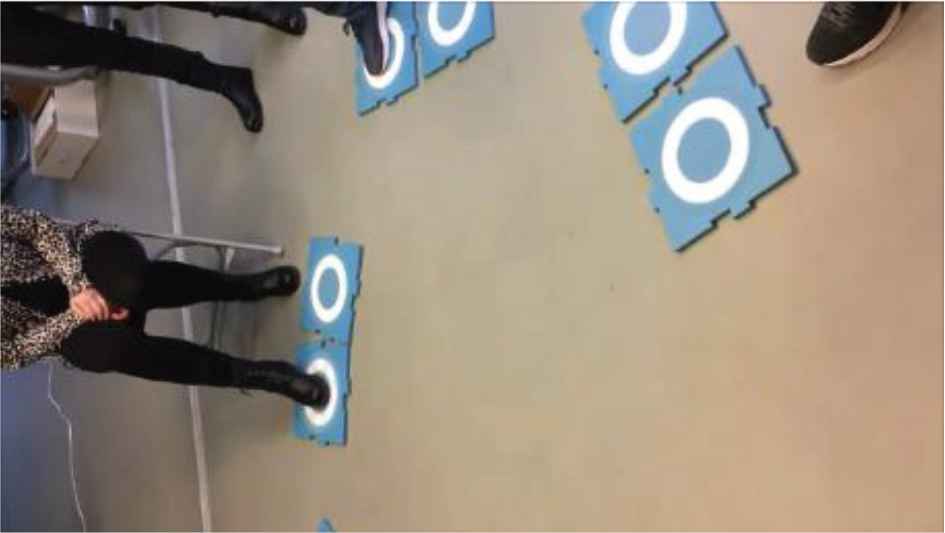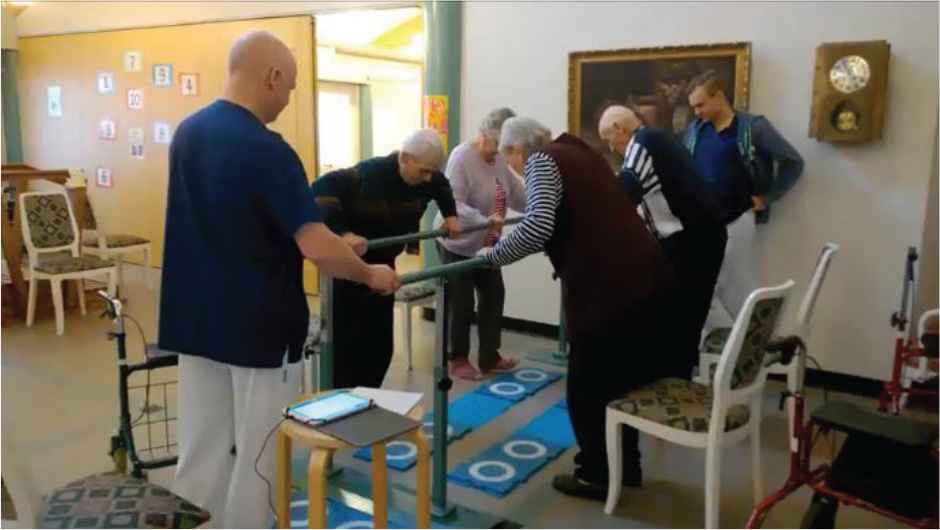Social Play Mediated by Playware
- DOI
- 10.2991/jrnal.k.200528.013How to use a DOI?
- Keywords
- Playware; social play; playware ABC; Moto Tiles; games
- Abstract
In this paper, we describe a set of designs of social playware by using the Moto Tiles. We tried to demonstrate the importance of the development of social playware by designing a number of social games that people can play together on one single tool. The design envisions play that mediates coordination among participants. We make use of play that is physically stimulating, that is cognitively exciting, that can be changed by arranging diverse layouts of the tiles, and that is enriched by different sensor modalities, etc. In all cases, the games and interaction designs are guided by the Playware ABC concept that is focused on creating social play opportunities for Anybody, Anywhere, Anytime, by Building Bodies and Brains, and thereby by facilitating the work of therapists and care workers can easily Construct, Combine, and Create new social play interactions to fit their particular users need.
- Copyright
- © 2020 The Authors. Published by Atlantis Press SARL.
- Open Access
- This is an open access article distributed under the CC BY-NC 4.0 license (http://creativecommons.org/licenses/by-nc/4.0/).
1. INTRODUCTION
In the last 30 years, the interest of the scientific world about the growth and, oppositely, the declining of mental and physical health amongst people has largely and constantly increased. We started observing and studying both children and seniors, and theorists have begun to develop theories linking growth and decline to either increasing or decreasing opportunities to engage in play. A large number of researches – in the areas including psychology, anthropology, education, sociology, and physiotherapy – offer a new blend of practical and theoretical perspectives that may shed further light on this topic, while one single thing seems to emerge from all of the studies, continuously. That is that free play in children accelerates the growth of mental abilities [1–4] and that social play in adults decelerates the degeneration of the mental abilities [5] besides also improving their general attitude in relationships, mood, and physical strength. There is a large set of researches that demonstrate how play in adults and elderly citizens relieves stress, improve brain functions, stimulate the mind and boost creativity, improve relationships and your connection to others. It determines a general sensation for people feeling younger and more energetic, besides healing physical and emotional wounds. Despite of that, sometimes, to get elderly people engaging in social play can be difficult, and we believe some special settings and that some specific tools could greatly help in reaching such target. Because of that, in the last decade we have progressively increased our research on how to build play tools and games that facilitate social play by increasing the level of communication between participants, and mediating coordination among actors. All of that it is not obvious, especially if such games and such tools have to engage and keep people from any age on being continuously engaged and still require to be both physically and mentally challenging.
In this paper, we describe part of the multiple field’s experiences and observations achieved by running the Moto Tiles platform [6,7], a platform that we have constantly evolved either in terms of hardware, software and gaming in the last twenty years, and that is in turn giving magnificent result in therapeutic, social and psychological terms. Finally, we also describe some of the most effective social games obtained.
2. SOCIAL GAMES
The use of Moto Tiles for group games it is thought to be split in two specific branches:
- (1)
Cooperative Group Games (SGG), where a cluster of persons pushes together toward a common target (i.e. usually, reaching a specific goal);
- (2)
Competitive Group Games (CGG), where two or more groups compete to reach a wider, larger, bigger or faster goal in a specific situation (i.e. usually, scoring points).
The two kind of games have their specific psychological, sociological, pedagogical, and therapeutic functions and impact. We will not discuss that aspect in this paper although when considering social games, most likely, it is the most important factor to analyze.
Further, the above distinction is mostly theoretical since, sometimes, the very same game can be interpreted/played both in a cooperative and/or a competitive way.
As a final premise, it is to be underlined that, normally, in order to get CGG up and running, with Moto Tiles, we often need to define how a group can be identified on the playfield. There are many possibilities, but we usually use colors, meaning that each group is represented by a specific color.
2.1. Smash Group Game
The Smash Group Game is a simple game that can be played both as a SGG or a CGG.
As a SGG, once defined the number of participants (i.e. three to max eight for each set of tiles) it will be played with a number of tiles that has to be larger than the number of players. Tiles can be positioned on the playfield both in an ordered and contiguous way or randomly. Once the participants are ready, the game is started and at each cycle the master-tablet will activate (i.e. turn on) a subset of tiles, equivalent to the number of players. To accomplish the sub-task given in every cycle, each participant has to jump on a tile and keep pressing the central button until all of the players are on all of the active tiles. Every single cycle performance, if properly accomplished, will end when all the active tiles are being pressed (i.e. an active tile shows a continuous light, while an active tile when pressed shows an intermitting light) or, if there are some unpressed active tiles, when the cycle times out. As you can easily imagine, the group has to be as fast and as accurate as possible. The average response of the group can be calculated over time and the master-tablet can provide feedback for the group speed/accuracy, as a single parameter to refer to. If appropriately executed, the game itself can be very playful, funny and has a great call upon social interaction.
The very same game can be interpreted in a CGG way. The only real difference is the master-tablet has to be predisposed for running a number of groups (i.e. two or three) with a specific number of participants (i.e. not necessarily homogeneous). Once tiles and people are appropriately disposed in the room, the game is started. Of course, each sub-group will be identified by a specific color. The game remains the same although the results will be, in this case, interpreted in terms of competition amongst groups, and the tiles feedback and analysis will be presented so that there is a winner for each single cycle and a sort of score for the whole “tournament”.
2.2. Colors Group Game
The Colors Group Game is another simple game that can be run both on SGG or CGG modality, although in our opinion the cooperative one is the most appropriate.
In this game, each single player gets as identity a single color, which will represent her/him both as a colored tile-target and as a colored jacket or a handkerchief, or headscarf to be somehow worn.
For this game we envision three to max 10 players – accordingly with the number of people in the group/s, the number of tiles at hand, and with the number of distinguishable colors that can be expressed (unfortunately colors perception also depends on lighting context of the playfield/room).
At each game cycle, the master-tablet randomly distribute a number of lit up tiles so to cover all of the participants/colors range. At that point every player has to run to its tile-target and disactivate it as fast as possible. Essentially, this is a multiplayer version of the well-known Color Race game on the Moto Tiles.
The feedback provided by the game depends on the chosen modality. In the cooperative/SGG one we show the average result of the group (i.e. in terms of timing), while in the competitive/CGG we prefer to show the ranking of each group/color.
We consider this application at its start since there are many possible variations of it to test, measure and eventually apply.
2.3. Patterns Group Game
The Patterns Group Game is one more game that can be used in both SGG or CGG situations.
It is quite dissimilar to the two games presented above since it does not produce stimuli for the groups simultaneously, but sequentially. As for the Colors Group Games each group is identified by a specific code that, in this case, is not a color but a specific pattern shown through the tiles’ LEDs. A pattern, of course, is a specific geometrical configuration of the lit up eight-LEDs embodied in each tile, which can resemble a typical shape (i.e. circle, square, triangle, etc.).
The tiles can be freely distributed on the floor and the master-tablet only needs to know how many groups are there and show, for each of them, a specific geometrical pattern that will be the target for each individual/group.
Each run/cycle consists of a number of reiterations during which only a single tile, amongst all, will be lighted up with one specific pattern at time. All the patterns will be presented, in turn, but not necessarily in order, one after another. For example, if we have 10 tiles, two group (i.e. A and B) with two patterns (i.e. a and b) there might be 10 reiterations where the sequence five times a and five times b is randomly chosen. (e.g. AABABBBAB, or ABBAAABAB, etc.).
At every reiteration, each group will have two target tiles. One is the matching-tile and the other one is the target-tile. The matching-tile is a tile proper of each group that must be specified at beginning of the game and is positioned close to one player, the matching-player.
Therefore, for every reiteration of the game, one target-tile is lit up with a specific target, while all the matching tiles of all groups are lit up.
The first player/group which select its own matching-tile takes the turn. Indeed, the matching-tile once pushed will attribute, right or wrong, the specific reiteration to an unambiguous pattern/group.
Only after that smash/activation the target pattern tile can be switched off. Consequentially, a reiteration can be considered finished only when both a matching-tile, first, and the target-tile, secondly, are pressed.
The largest difference between the two former games and the Pattern Group Game is that cooperation and attentional demand in the latter one is much higher either in terms of visual perception, or motor reaction as well as group coordination.
The outcome of the game can be presented in different ways, therefore either as absolute hit/errors points scored, or as average reaction times for hit, or as a mixed component of all of them.
Other social play games include:
2.3.1. Jump jump
The Jump Jump Game for more players, where two tiles light up and two players have to hit them at the same time. For instance, with 10 players each player has one tile, and with five players, each player may have two tiles (Figure 1). In this game, the players have to coordinate their interaction, so that they are in synchrony when hitting the tiles that light up. The game was originally designed as a one-player game for the player to jump on the tiles landing with his/her feet in synchrony on the two tiles lit up, but the game was later adopted by therapists to become a social play for many players. This exemplifies well how the C of the Playware ABC concept allowed the therapist to construct, combine and create using their professionalism to develop a social play which matched their need for a tool to mediate social interaction and social enjoyment among the seniors.

The Jump Jump Game where players can both sit down and stand up while playing together.
2.3.2. Piano
The Piano Game where each tile with a distinctive color represents a note. In the game a tune is played and each player has to hit the tile in front of him/her to make the appropriate note (Figure 2). Similar to the Jump Jump Game, also this game was originally designed to be a single player game. Similarly, with the Piano Game the C of the Playware ABC facilitated that the therapist could easily construct their own new version of the game as a social play for more users. In this way, seniors now group around the Moto Tiles (Figure 2) and together they perform piano melodies such as Twinkle Twinkle Little Star and When the Saints Go Marching In.

The Piano Game amongst seniors and therapist in Finland.
2.3.3. Color race
The Color Race Game where up to four players are competing on catching their color which jumps around on the tiles. Each player has his/her own color, which jumps to another randomly chosen tile when the tile with this color is pressed. The player who first catches 10 wins the game (Figure 3). This is the original use of the game as either a single player or a multiplayer game. The therapists adopts this use also to allow users of different ages to perform social play, such as in intergenerational play between kindergarten children and senior care home residents (Figure 3).

Social intergenerational play on Moto Tiles by Culture Homes in Hong Kong.
3. DISCUSSION AND CONCLUSION
In this paper we described an initial set of six games to be run on our playware platform, that point directly at eliciting a deep social interaction. Indeed, in our point of view, it is important to expand the playware research to focus on the social interaction, so that the starting point for the research and development becomes the social interaction mediated by the technology rather than the individual interaction mediated by the technology. We can define social playware as follows: social playware is playware, which aims at creating playful social interaction between several users [8].
We focus on such social playware because we believe, as almost all the scientific community seems to be aware now, that social play is fundamental for both mental and physical growth and maintenance. Indeed, there are many studies [1–5] carried on children and elderly population that show the multiple benefits of such an activity, improvements that go from the not concretely defined “wellness” to the more specific results obtained in the muscular, skeletal, cardio-circulatory, respiratory, metabolic systems, as well as the nervous one in terms of cognitive and emotive apparats. Therefore, working on a technology that stimulate gaming and social interaction and that parallelly produce a deterministic level of automated measurement in terms of behavioral response, it seems to be the right way to spend a scientific effort.
CONFLICTS OF INTEREST
The authors declare they have no conflicts of interest.
ACKNOWLEDGMENT
The authors wish to thank Massimiliano Leggieri for the help in developing the first prototype system.
AUTHORS INTRODUCTION
Professor Luigi Pagliarini
 He is an artist with a strong neuro-psychological background that has become an expert in Artificial Intelligence, Artificial Life, and Robotics. He is a Professor at the Academy of Fine Arts of Macerata, in Italy. He has hundreds of publications and of quotations both in science and arts, and has exhibited his work all over the world, as well as has been awarded of different international prizes.
He is an artist with a strong neuro-psychological background that has become an expert in Artificial Intelligence, Artificial Life, and Robotics. He is a Professor at the Academy of Fine Arts of Macerata, in Italy. He has hundreds of publications and of quotations both in science and arts, and has exhibited his work all over the world, as well as has been awarded of different international prizes.
Professor Henrik Hautop Lund
 He is at Center for Playware, Technical University of Denmark, is World Champion in RoboCup Humanoids Freestyle 2002, and has more than 200 scientific publications and 5000 citations. He was awarded the Most Outstanding Healthcare Innovator in the World in 2019. Over the last year, he received international awards in Tokyo, Singapore, and London. He has developed shape-shifting modular robots, presented to the emperor of Japan, and has collaborated closely on robotics and AI with companies like LEGO, Kompan, BandaiNamco, Microsoft, Mizuno. He is the inventor of the Moto Tiles (www.moto-tiles.com), which are used by seniors all around the world.
He is at Center for Playware, Technical University of Denmark, is World Champion in RoboCup Humanoids Freestyle 2002, and has more than 200 scientific publications and 5000 citations. He was awarded the Most Outstanding Healthcare Innovator in the World in 2019. Over the last year, he received international awards in Tokyo, Singapore, and London. He has developed shape-shifting modular robots, presented to the emperor of Japan, and has collaborated closely on robotics and AI with companies like LEGO, Kompan, BandaiNamco, Microsoft, Mizuno. He is the inventor of the Moto Tiles (www.moto-tiles.com), which are used by seniors all around the world.
REFERENCES
Cite this article
TY - JOUR AU - Luigi Pagliarini AU - Henrik Hautop Lund PY - 2020 DA - 2020/06/03 TI - Social Play Mediated by Playware JO - Journal of Robotics, Networking and Artificial Life SP - 133 EP - 136 VL - 7 IS - 2 SN - 2352-6386 UR - https://doi.org/10.2991/jrnal.k.200528.013 DO - 10.2991/jrnal.k.200528.013 ID - Pagliarini2020 ER -
